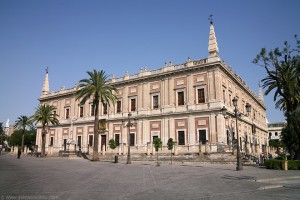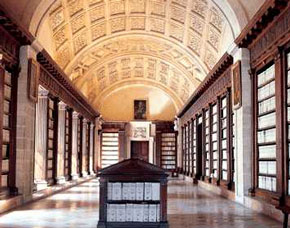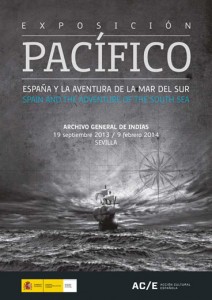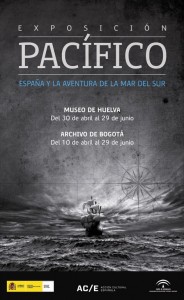During my research trip to Seville in January 2014, and then again in March, I had the opportunity to visit the exhibition Pacífico: España y la aventura de la Mar del Sur (Pacific : Spain and the adventure of the South Sea). It was hosted in the magnificent building situated between the Cathedral and the Real Alcazar, that was used as Casa de la Contratación when it opened in 1598, and then, from 1775 till the present, is the site of the Archivo General de Indias.
This is the Spanish colonial archive par excellence, holding kilometers of manuscripts and precious maps spanning approximately four centuries of the Spanish colonization of America (including the Philippines). As such, it was a perfect location for an exhibition that aimed to explore the relationship between Spain and the Pacific in the event of the fifth anniversary of Vasco Nuñez de Balboa’s first “discovery” of what would later become “the Spanish lake” (1513).
The exhibition focused on the first century of that relationship, and I was especially struck by the effective way in which the presentation of the materials was rooted in the very architecture of the building. The exhibitions run through three long galleries on the first floor, each of them clearly coupled with one main issue. The first gallery hosted manuscripts, letters, drawings and maps regarding the initial exploration of the coastal territories stretching from present-day Panama to Chile, and the first encounter with the native populations of the area. The second gallery focused on the complex endeavor of sailing the Pacific from the American to the Asian coasts, and back. A series of panels hanging on the two sides showed the routes followed by the explorers during the 16th century, and accompanied the visitors through their sail across a large space where only a few scattered islands/manuscript were placed.
At the end of this virtual crossing, a Chinese map dated 1555 signalled the beginning of the third gallery, where a vast number of fascinating objects were exhibited, suggesting the rich (and not always Pacific) encounters between the Spaniards and the many inhabitants of the Asian archipelagos and continent (including the subjects of other European competing powers).
Back in Seville at the end of May, I was curious to see how the contents of the exhibition had been rendered in the catalogue, without the support of such a unique location as the building of the Archivo General de Indias. The fact that the catalogue was sold out only made my curiosity bigger. I finally found it at the library of another important research institution in Seville, the Escuela de Estudios Hispano-Americanos (EEHA – http://www.eeha.csic.es/biblioteca.html).
Unsurprisingly, the catalogue features a considerably different structure than the exhibition. Here the material is presented in seven sections/chapters that suggest an overall quest for a more analytical approach. The contents of the first gallery of the exhibition are now distributed in the first three chapters (“The adventure of the South Sea”, “An incomplete world” and “The discovery of the South Sea”); the crossing in the second gallery becomes a much easier reading of a chapter on “The exploration of the Pacific Ocean”; the last three chapters present different aspects of the encounters in Asia, and more explicitly point to the transition from the first precarious attempts to cross the South Sea to the regular route established between Acapulco and Manila by the second half of the 16th century (the so-called Galeón de Manila and Nao de China).
Excellent pictures of the objects are provided, and boxes reproduce some of the manuscripts originally exhibited in the archive. But in the fabric of the volume words inevitably substitute the materiality of objects and architectures. The exhibition curators’ preface and, most importantly, the conclusions by Salvador Bernabeu Albert on “The historiographical legacy of the Pacific” here become prominent. Moreover, in each chapter, one text written by renowned (Spanish) scholars holds together the visual parts and suggests ways to interpret them. Consequently, the voice of the historians is loud in the publication, while in the exhibition the visitors had an allegedly more direct relationship with the sources, and could choose to receive the expert’s support by listening (with headphones) to short edited interviews made available on small screens in rather marginal locations throughout the galleries.
Unexpectedly, some information is somehow “lost in translation” from the exhibition to the volume, notwithstanding the more analytical approach of the latter. In the exhibition, for instance, the number of deaths among the crews of the first ships exploring the Pacific was clearly indicated on smaller panels located just below the hanging ones. Conversely, only the latter are reproduced in the volume, providing a somehow more linear idea of the exploration and downplaying its human costs.
One last observation, and a final call for cooperation to our blog readers. Since the end of April the exhibition moved from Seville, and it is now shown at the same time at the Provincial Archive in Huelva, Spain, and the Archive of Bogotá, Colombia. It will remain in both locations until 29 June 2014. I was not able to find out whether the exhibition is travelling further after that date, and eventually where to. Needless to say, it would be very interesting to know exactly how the material is presented in both locations, and actually what objects are exposed where. If you happen to visit the exhibition, will you be so kind as to post your description and comment here? Many thanks!






 Subscribe to Christian De Vito's posts
Subscribe to Christian De Vito's posts
Thank you for your comments. As one of the curators, I am glad to read how interesting was this exhibition for the public and for you. I accept also your critics, which I will take into consideration. A. Sánchez de Mora